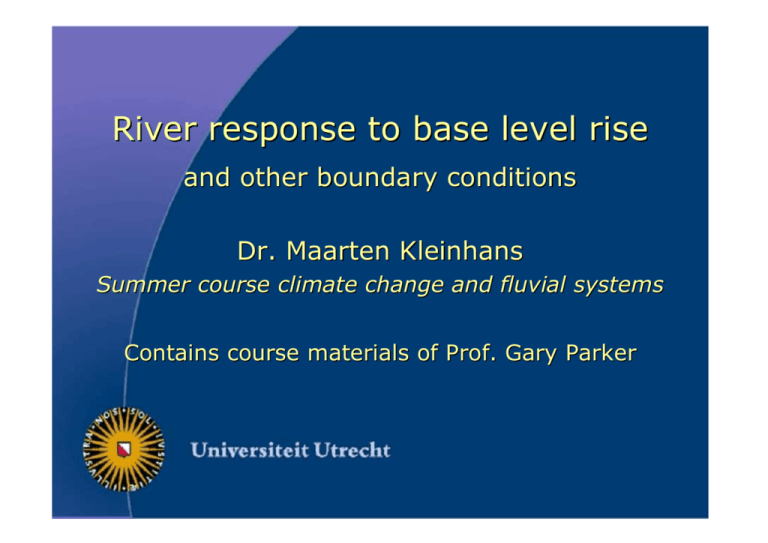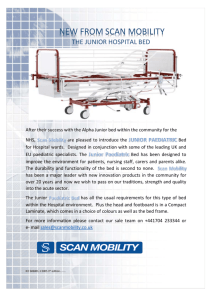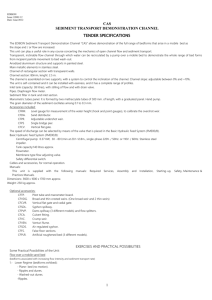River response to base level rise
advertisement

! " # $ % % ! & '((!!! & *() ( () ( +, 1D SEDIMENT TRANSPORT MORPHODYNAMICS with applications to RIVERS AND TURBIDITY CURRENTS © Gary Parker November, 2004 . &0 1 , / % $# % % &2 & ! &4 % ' %3 ' ' 3 3 * 5 0 ! % flow 6 7 Sediment tr. " 8 morphology ! 7 3 9 6 % 3 % example connections ! ! ( R u= 2/3 S 1/ 2 n u = C RS ) !' : % ! ; 8 gRS u= f 6 ' C = αr , %," H kc 1/ 6 * ! ! , < < % # < < <6 < % =,> ?? ' # ' % % ! @ % < - . 3 / ) " S=u3 or u5 S Savg Q Q X probability Qchannel forming 7 . %/ ! ' 8 Q flow discharge m3/s Q = Au A ≈ Wh → Q = Whu H depth bankfull u flow velocity Area (bankfull) Width wetted Perimeter 0 % 4 0 &5 % % % AA?,A= % 0 flood Q low flow t 7 " ! !3 "1A. / water surface elevation (base level) is raised at t = 0 by e.g. installation of a dam sediment supply remains constant at qsa η antecedent equilibrium bed profile established with load qsa before raising base level About Froude: subcritical and supercritical flow • slow • downstream control • fast • no downstr. control • Fr < 1 • Fr > 1 " bed shear stress (and sediment mobility) τ = ρgR sin (S ) ≈ ρgRS τ τ* = [(ρ s − ρ )gD50 ] Flow shear stress on the bed (Newton) Shields number: Sediment-entraining ‘force’ vs. sediment-detraining ‘force’ " , ' ( q = αt τ −τ ∗ t ∗ α1B3 1=C $ ) ∗ nt c , τ >τ ∗ ' qt q = [( ρ s − ρ ) / ρ s ]gD D ∗ t ∗ c 4 ' Shields mobility number 10 Suspended transport Bed load transport 1 RIJN ALLIER 0,1 GRENSMAAS Shields criterion 0,01 sand silt 0.1 gravel 1 10 Grain size/diameter (mm) 100 4 ' ♣ Allier ♦ Meuse ♥ Rhine ♠ Volga Braiding, often Fr~1 Stream power (Van den Berg, 1995) ♣ ♥ ♠ ♦ Meandering, often Fr<<1 Grain size " = # 7 ' D36 . ! ' D1 ! . 1 , > ? F ; . " " = > G H 8 # " % C " . =/ . E=/ / %/ 1 . "/=(> 3 % / ' S ∂η ∂qb (1 − λ p ) =∂x ∂t , - transport gradient λ=poros η=bed level qb=transp t=time x=location % ∂η ∂qb (1 − λ p ) =∂x ∂t %' = > ? F C G $8 ' ∂η ∂ " % 5 7 % ∂ ∂ % ∂# (∂8/ . % % α $8 % β ! 5' parameter ~63 % of change accomplished at T time " = # ' " = > . ?/ # ! ! I $% ' 3 3 $& ' ' % ' ! " > # $! 6 D. # / ' ' %( % $# = 7 ' ,J ! ,J > 725' ,J -9 8 I discharge and sediment feeder slope i water depth h1 water grain flow depth thickness h0 hg sediment bed " # ' % ? = ' ? - ' ( $ -. 7 . % % ! 3 % / 3 " 3 / . 3 / .! / %! C ' ! ; % F . ?/ ( !) ( !) $ $! ! *$ $!, $! ! % ) %+! ! !! %$ ! % + ! 0$ ' % %D3 D3 = % ! % ( ! F " % % . % , / >,F ! % > ? ! ! % 8 2 ! 4 % ! 4 % $ % 6/ $ . " */ $8 '" D # 6. / % ; " . K 3 %/ 8 . I % 9 -7 % 8 Long Profile of the Amazon River 3000 2500 η (m) 2000 1500 1000 500 0 -7000 -6000 -5000 -4000 -3000 x (km) -2000 -1000 0 D < L# , # M # ! % # ! 5 % ! % ' < < < < < < < " " ,J % ! 4 $ 4 ' ! ,J ! % ,J ' ,J % % %- $ ! The Kosi River flows into a zone of rapid subsidence. Subsidence forces a streamwise decline in the sediment load in a similar way to sea level rise. Note how the river width decreases noticeably in the downstream direction. https://zulu.ssc.nasa.gov/mrsid/mrsid.pl 7 ! 5% % N : Ultimate water surface Initial water surface Ultimate bed Initial bed η transient bed profile (prograding delta) % 0 %% . ' D % /' % final equilibrium bed profile in balance with load qt > qta transient aggradational profile sediment supply increases from qta to qt at t = 0 η antecedent equilibrium bed profile established with load qta $8 %% ( % Bed evolution 160 0 yr 5 yr 10 yr 15 yr 20 yr 25 yr Ultimate 140 100 80 60 40 degradation 20 0 0 2000 4000 6000 8000 Bed evolution 10000 Distance in m 90 80 aggradation 0 yr 20 yr 40 yr 60 yr 80 yr 100 yr Ultimate 70 Elevation in m Elevation in m 120 60 50 40 30 20 10 0 0 2000 4000 6000 Distance in m 8000 10000 % Bed evolution (+ Water Surface at End of Run) 25 Elevation in m 20 bed 0 yr bed 20 yr bed 40 yr bed 60 yr bed 80 yr bed 100 yr bed 120 yr ws 120 yr 15 10 5 0 -5 0 10000 20000 30000 Distance in m 40000 50000 $8 ! ! ! " #$ ! " % & https://zulu.ssc.nasa.gov/mrsid/mrsid.pl % % 7 5 # % η 8 D = 5, 4% %O # 8 ! > 5, = ! %7 9 , ? 5, % 4% %7 8 % F 5, 4% %O 8 I O 8 8 , Calculation of River Bed Elevation Variation with Normal Flow Assumption (Qf) (Inter) (B) (D) (lamp) Calculation of ambient river conditions (before imposed change) Assumed parameters Q 70 m^3/s Flood discharge If 0.03 Intermittency The colored boxes: B 25 m Channel Width indicate the parameters you must specify. D 30 mm Grain Size The rest are computed for you. λp 0.35 Bed Porosity (kc) kc (S) S 75 mm 0.008 Roughness Height If bedforms are absent, set kc = ks, where ks = nk D and nk is an order-one factor (e.g. 3). Ambient Bed Slope Otherwise set kc = an appropriate value including the effects of bedforms. Computed parameters at ambient conditions H 0.875553 m Flow depth (at flood) τ* 0.141503 Shields number (at flood) q* 0.232414 Einstein number (at flood) qt 0.004859 m^2/s Volume sediment transport rate per unit width (at flood) Gt 3.05E+05 tons/a Ambient annual sediment transport rate in tons per annum (averaged over entire year) Calculation of ultimate conditions imposed by a modified rate of sediment input Gtf 7.00E+05 tons/a Imposed annual sediment transport rate fed in from upstream (which must all be carried during floods) qtf 0.011161 m^2/s Upstream imposed volume sediment transport rate per unit width (at flood) τult∗ 0.211523 Ultimate equilibrium Shields number (at flood) Sult 0.014207 Ultimate slope to which the bed must aggrade Hult 0.736984 m Ultimate flow depth (at flood) Click the button to perform a calculation Calculation of time evolution toward this ultimate state L qt,g ∆x ∆t 10000 0.011161 1.67E+02 0.01 m m^2/s m year length of reach Ntoprint sediment feed rate (during floods) at ghost node Nprint spatial step M αu time step Duration of calculation 200 5 60 0.5 10 Number of time steps to printout Number of printouts Intervals Here 1 = full upwind, 0.5 = central difference years 8 ,







